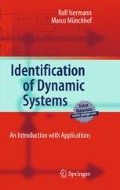Abstract
Subspace methods can identify state space models if only input and output measurements are available. Since no measurements of the states are required and employed, it is not possible to come up with a unique structure, hence the model is only known up to a similarity transform T. Interesting features of the state space identification are the fact that subspace identification allows to determine the suitable model oder as part of the identification process and furthermore, the method is from the very beginning formulated to cover MIMO systems as well. A short history of subspace methods can e.g. be found in the editorial note by Viberg and Stoica (1996).
Access this chapter
Tax calculation will be finalised at checkout
Purchases are for personal use only
Preview
Unable to display preview. Download preview PDF.
References
Bauer D (2005) Asymptotic properties of subspace estimators. Automatica 41(3):359–376
Chiuso A, Picci G (2005) Consistency analysis of some closed-loop subspace identification methods. Automatica 41(3):377–391
Chou CT, Verhaegen M (1999) Closed-loop identification using canonical correlation analysis. In: Proceedings of the European Control Conference 1999, Karlsruhe, Germany
Golub GH, van Loan CF (1996) Matrix computations, 3rd edn. Johns Hopkins studies in the mathematical sciences, Johns Hopkins Univ. Press, Baltimore
Ho BL, Kalman RE (1966) Effective construction of linear state variable models from input/output functions. Regelungstechnik 14:545–548
Houtzager I, van Wingerden JW, Verhaegen M (2009) Fast-array recursive closedloop subspace model identification. In: Proceedings of the 15th IFAC Symposium on System Identification, Saint-Malo, France
Jansson M (2005) A new subspace identification method for closed loop data. In: Proceedings of the 16th IFAC World Congress
Juang JN (1994) Applied system identification. Prentice Hall, Englewood Cliffs, NJ
Juang JN, Phan MQ (2006) Identification and control of mechanical systems. Cambridge University Press, Cambridge
Katayama T, Tanaka H (2007) An approach to closed-loop subspace identification by orthogonal decomposition. Automatica 43(9):1623–1630
Lin W, Qin SJ, Ljung L (2005) Comparison of subspace identification methods for systems operating in closed-loop. In: Proceedings of the 16th IFAC World Congress
Ljung L (2009) Aspects and experiences of user choices in subspace identification methods. In: Proceedings of the 15th IFAC Symposium on System Identification, Saint-Malo, France, pp 1802–1807
Ljung L, McKelvey T (1996) Subspace identification from closed loop data. Signal Process 52(2):209–215
Massiono P, Verhaegen M (2008) Subspace identification of a class of large-scale systems. In: Proceedings of the 17th IFAC World Congress, Seoul, Korea, pp 8840–8845
van Overshee P, de Moor B (1994) N4SID: Subspace algorithms for the identification of combined deterministic-stochastic systems. Automatica 30(1):75–93
van Overshee P, de Moor B (1996a) Continuous-time frequency domain subspace system identification. Signal Proc 52(2):179–194
van Overshee P, de Moor B (1996b) Subspace identification for linear systems: Theory – implementation – applications. Kluwer Academic Publishers, Boston
van Overshee P, de Moor B (1997) Closed loop subspace systems identification. In: Proceedings of the 36th IEEE Conference on Decision and Control, San Diego, CA, USA
Rao GP, Unbehauen H (2006) Identification of continuous-time systems. IEE Proceedings Control Theory and Applications 153(2):185–220
Verhaegen M (1993) Application of a subspace model identification technique to identify LTI systems operating in closed-loop. Automatica 29(4):1027–1040
Verhaegen M (1994) Identification of the deterministic part of MIMO state space models given in innovations form from input-output data. Automatica 30(1):61–74
Viberg M, Stoica P (1996) Editorial note. Signal Proc 52(2):99–101
Author information
Authors and Affiliations
Corresponding author
Rights and permissions
Copyright information
© 2011 Springer Berlin Heidelberg
About this chapter
Cite this chapter
Isermann, R., Münchhof, M. (2011). Subspace Methods. In: Identification of Dynamic Systems. Springer, Berlin, Heidelberg. https://doi.org/10.1007/978-3-540-78879-9_16
Download citation
DOI: https://doi.org/10.1007/978-3-540-78879-9_16
Published:
Publisher Name: Springer, Berlin, Heidelberg
Print ISBN: 978-3-540-78878-2
Online ISBN: 978-3-540-78879-9
eBook Packages: EngineeringEngineering (R0)

